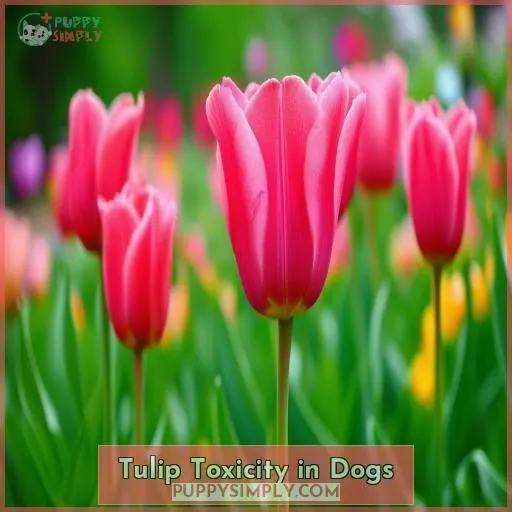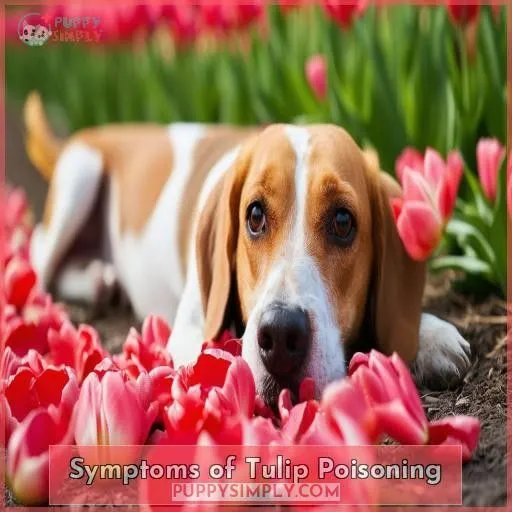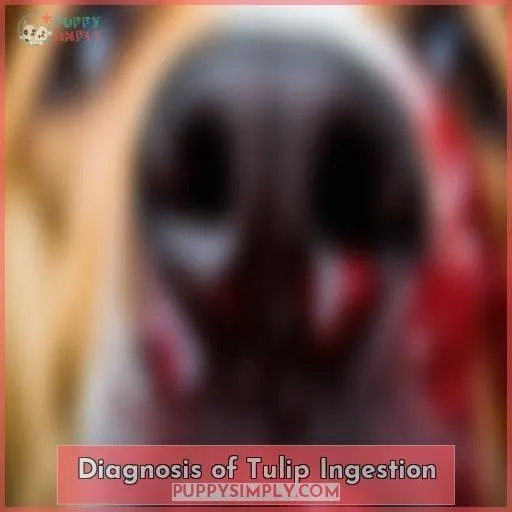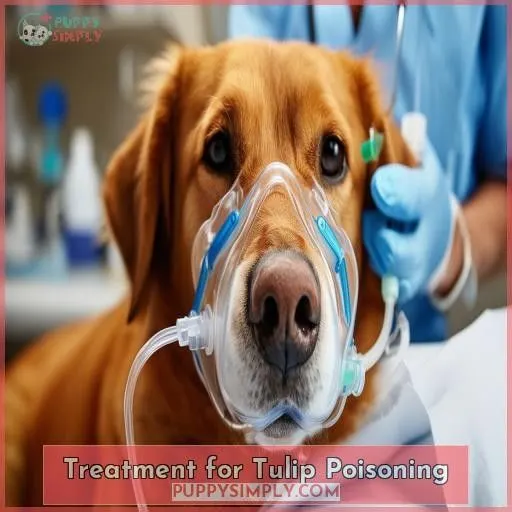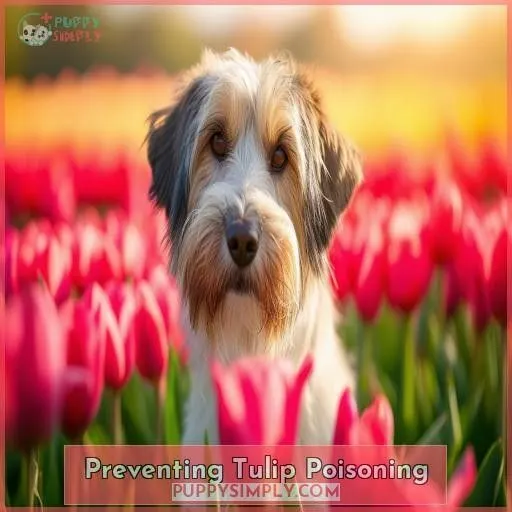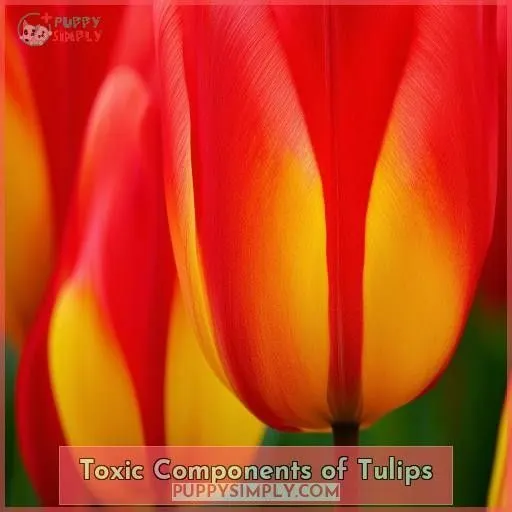This site is supported by our readers. We may earn a commission, at no cost to you, if you purchase through links.
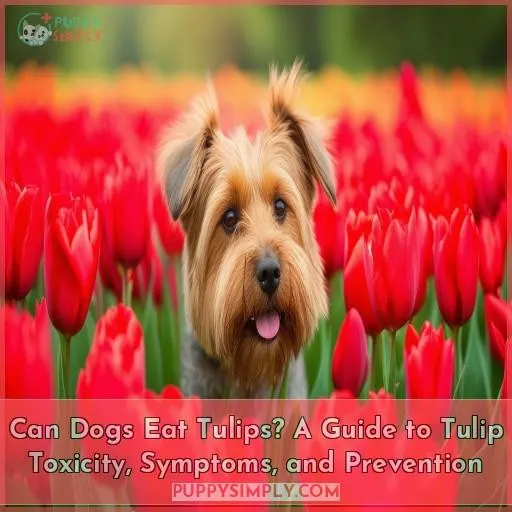 No, dogs can’t eat tulips.
No, dogs can’t eat tulips.
These popular spring flowers contain toxic alkaloids that can severely poison your pup. Even small ingestions can lead to vomiting, diarrhea, abnormal heart rates, neurological issues, and potentially fatal complications.
Prevention is key – keep tulips out of reach and monitor your dog closely when outdoors. If you suspect tulip poisoning, seek immediate veterinary care. Decontamination and supportive treatment may be required, and your vet will provide guidance on managing the toxicity.
For your dog’s safety, admire tulips from afar and opt for pet-friendly plants instead.
Table Of Contents
- Key Takeaways
- Can Dogs Eat Tulips?
- Tulip Toxicity in Dogs
- Symptoms of Tulip Poisoning
- Diagnosis of Tulip Ingestion
- Treatment for Tulip Poisoning
- Preventing Tulip Poisoning
- Toxic Components of Tulips
- Other Toxic Spring Plants
- Pet-Friendly Gardening Tips
- Frequently Asked Questions (FAQs)
- What should I do if my dog eats a tulip?
- Are tulips pet safe?
- Are tulip stems poisonous?
- Do any animals eat tulips?
- What part of tulips is most toxic?
- How long after ingestion do symptoms appear?
- Can tulips cause long-term health issues in dogs?
- Are tulips more toxic to certain dog breeds?
- Can tulip water cause poisoning if ingested?
- Conclusion
Key Takeaways
- Tulips are a gorgeous pop of springtime color, but let’s keep them on a strict look-but-don’t-lick basis for our furry friends. These flowers pack a serious toxic punch for pups.
- If your curious canine happens to sneak a taste of tulip, don’t panic, but do act fast. Vomiting, diarrhea, and even abnormal heart rhythms could be on the menu, so get your vet on the line ASAP for decontamination and support.
- While tulips may seem harmless enough, their toxin levels are no joke. Even small nibbles can potentially lead to long-term organ damage or worse. So let’s agree to keep these beauties firmly in the look but don’t touch category for our four-legged pals.
- Thankfully, there are plenty of pet-friendly alternatives to brighten up your garden beds without risking any furry family members. Snap up some snapdragons, dazzle with zinnias, or let the sunshine in with sunflowers – your pup will thank you!
Can Dogs Eat Tulips?
No, dogs can’t eat tulips safely. Tulips are toxic to dogs and can cause vomiting, diarrhea, drooling, and even heart problems or neurological issues if ingested.
Tulip Toxicity in Dogs
Tulips contain toxic alkaloids like Tulipalin A and B, with the highest concentration in the bulb.
Even small amounts can cause severe tulip poisoning in dogs, leading to gastrointestinal upset, nervous system interference, and potential fatality.
For pet safety, it’s essential to prevent dogs from ingesting any part of the tulip plant.
Understanding the risks and symptoms of tulip poisoning empowers responsible pet owners to take proactive measures and seek immediate veterinary care if accidental ingestion occurs.
Symptoms of Tulip Poisoning
If your dog ingests any part of a tulip plant, you may notice gastrointestinal distress such as vomiting, diarrhea, and abdominal pain. Additionally, tulip poisoning can lead to concerning neurological symptoms like depression, lack of coordination, and in severe cases, seizures or coma, making prompt veterinary care imperative.
Gastrointestinal Distress
If your canine companion ingests any part of a tulip, gastrointestinal upset is a common symptom. Be on the lookout for vomiting, diarrhea, and abdominal pain. These digestive issues indicate tulip poisoning, requiring prompt veterinary attention. While concerning, gastrointestinal distress can often be treated effectively with proper decontamination and supportive care under a vet’s guidance.
Neurological Effects
Tulip poisoning can impact your dog’s cognitive function and coordination. You may notice behavioral changes, tremors, weakness, or lethargy. Severe cases may lead to seizures or unconsciousness as toxins affect the nervous system. Prompt treatment is of the utmost importance, as neurological impacts from tulips, amaryllis, bluebells, or daffodils can be life-threatening without proper care.
Cardiac Complications
Though tulips may seem harmless, ingesting them can lead to cardiac complications for your dog. The toxins can cause irregular heart rhythms, potential heart failure, and other heart problems. So don’t risk it – keep tulips, and plants like daffodils, bluebells, amaryllis, and rhododendrons away from your furry friend.
Diagnosis of Tulip Ingestion
If your dog ingests a tulip, prompt action is critical. Look for signs like vomiting, diarrhea, or lethargy. Then:
- Collect any vomit or plant material
- Note when and what your dog consumed
- Contact your vet immediately, even if symptoms seem mild
Your vet may request a urine or blood sample to confirm tulip poisoning. Early diagnosis and treatment greatly improve your dog’s chances of a full recovery, so don’t delay. Tulips are highly toxic to dogs due to glycosides that can damage the heart and kidneys.
Treatment for Tulip Poisoning
If your dog has ingested tulips, you must act quickly to decontaminate. Inducing vomiting or administering activated charcoal may help remove toxins, but severe cases require veterinary intervention like gastric lavage and supportive care.
Decontamination Methods
If your dog ingests tulips, act quickly: perform vomiting induction if recent, then administer activated charcoal to absorb toxins. If time has passed, your vet may perform gastric lavage to flush the stomach.
| Decontamination Method | Description |
|---|---|
| Vomiting Induction | Induce vomiting if ingestion was recent to expel plant material. |
| Activated Charcoal | Binds to toxins, preventing further absorption. |
| Gastric Lavage | Flushes the stomach if significant time has elapsed. |
Time is critical – seek immediate veterinary care for tulip toxicity.
Supportive Care
You’ll need to hospitalize your dog for supportive care, such as intravenous fluids to prevent dehydration. Depending on your dog’s condition, medications like anti-arrhythmics or anti-seizure drugs may be needed. Dietary modifications and home care instructions will be provided upon discharge to aid recovery from tulip poisoning’s potential long-term effects.
Monitoring and Follow-up
You’ll need to monitor your dog closely after tulip poisoning. Follow-up care is essential to assess long-term effects and adjust treatment. Expect frequent vet visits to check for organ damage, anemia, or neurological issues. Recovery time varies, so be patient and consider holistic, stress-reducing approaches during convalescence.
Preventing Tulip Poisoning
Preventing tulip poisoning in your pets is vital for their safety.
Keep tulip bulbs and plants out of reach from curious pups by fencing off gardens or keeping them indoors.
When walking your dog, closely monitor them around unfamiliar areas where tulips may grow.
Creating a pet-friendly garden devoid of toxic plants eliminates risks and allows you and your furry companion to enjoy the outdoors worry-free.
Toxic Components of Tulips
To prevent tulip poisoning in dogs, you must understand the toxic components that make these spring flowers so dangerous. Tulips contain two potent alkaloids: tulipalin A and tulipalin B. These toxins can cause:
- Severe gastrointestinal distress
- Neurological issues like tremors
- Abnormal heart rate and arrhythmias
- Respiratory difficulties and failure
Even small ingestions of tulip bulbs, stems, or flowers can lead to serious animal toxicity requiring immediate veterinary care. Keeping dogs away from tulips is essential for their safety.
Other Toxic Spring Plants
While tulips pose risks to dogs, you should also be wary of other toxic spring plants like daffodils, crocuses, and lilies.
These can cause vomiting, lethargy, and even heart problems in pets.
Be especially vigilant with cats and horses, as many spring bloomers are toxic to them too.
Prevent accidental ingestion by fencing off garden areas and monitoring your pets closely when outside.
Consider pet insurance to cover any potential vet bills from poisoning incidents.
Pet-Friendly Gardening Tips
If you want a pet-friendly garden, carefully select plants that aren’t toxic. Consider these safe options:
- Snapdragons
- Marigolds
- Sunflowers
- Zinnias
Companion plant with herbs like rosemary or mint to deter pests naturally. Design paths and borders to contain curious pets. Always supervise when your furry friend explores the garden.
Frequently Asked Questions (FAQs)
What should I do if my dog eats a tulip?
If your dog eats a tulip, act quickly. Tulips are toxic and can cause vomiting, diarrhea, and heart problems. Induce vomiting if recent, then call your vet for further treatment instructions.
Are tulips pet safe?
Coincidentally, tulips pose a serious risk to pets. No, tulips aren’t pet-safe; ingesting any part can cause severe symptoms like vomiting, difficulty breathing, and heart problems. It’s essential to keep tulips away from pets and seek immediate veterinary care if consumption occurs.
Are tulip stems poisonous?
Yes, tulip stems are poisonous to dogs. Even small amounts can cause mouth irritation, vomiting, and diarrhea. If ingested, contact your vet immediately for proper treatment.
Do any animals eat tulips?
You’re right, tulips aren’t eaten by animals. Their toxicity makes them inedible and potentially life-threatening for pets like dogs and cats, as well as livestock. It’s wise to keep these beautiful but poisonous plants away from any curious critters.
What part of tulips is most toxic?
The tulip bulb contains the highest concentration of toxins like tulipalin alkaloids. It’s imperative to keep dogs far away from any part of the plant, as even small amounts can severely sicken them.
How long after ingestion do symptoms appear?
Symptoms usually appear within a few hours of ingestion, but can take up to 24 hours. Monitor your dog closely and contact your vet immediately if you suspect tulip poisoning.
Can tulips cause long-term health issues in dogs?
Yes, tulips can potentially cause long-term health issues for dogs. Their toxins may damage the liver, kidneys, and heart if ingested in significant amounts. Vigilant monitoring and treatment are essential to prevent lasting organ damage.
Are tulips more toxic to certain dog breeds?
No, tulip toxicity doesn’t seem to vary greatly across dog breeds. However, smaller dogs may experience more severe effects due to ingesting a higher toxin dose relative to their body weight. It’s best to keep all dogs away from tulips as a precaution.
Can tulip water cause poisoning if ingested?
Tulips contain toxins that can be hazardous if ingested by dogs. Yes, even the water from a tulip vase can potentially cause poisoning symptoms like vomiting, diarrhea, and difficulty breathing if consumed. Exercise caution and keep tulips out of reach from curious pets.
Conclusion
While tulips add vibrant beauty to gardens, you couldn’t find a worse snack for your canine companion.
To avoid severe, potentially fatal consequences, exercise eternal vigilance. Can dogs eat tulips? An emphatic no.
Follow preventative measures. Learn the signs of toxicity, and seek urgent veterinary aid if ingestion occurs.
With responsible precautions, you can safely enjoy these springtime gems alongside your furry friend.

